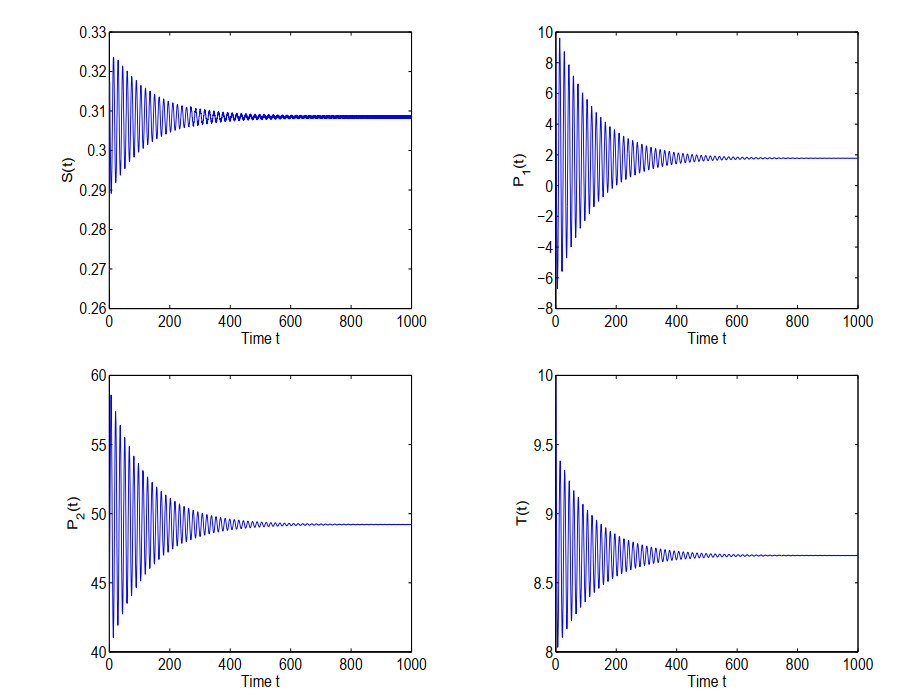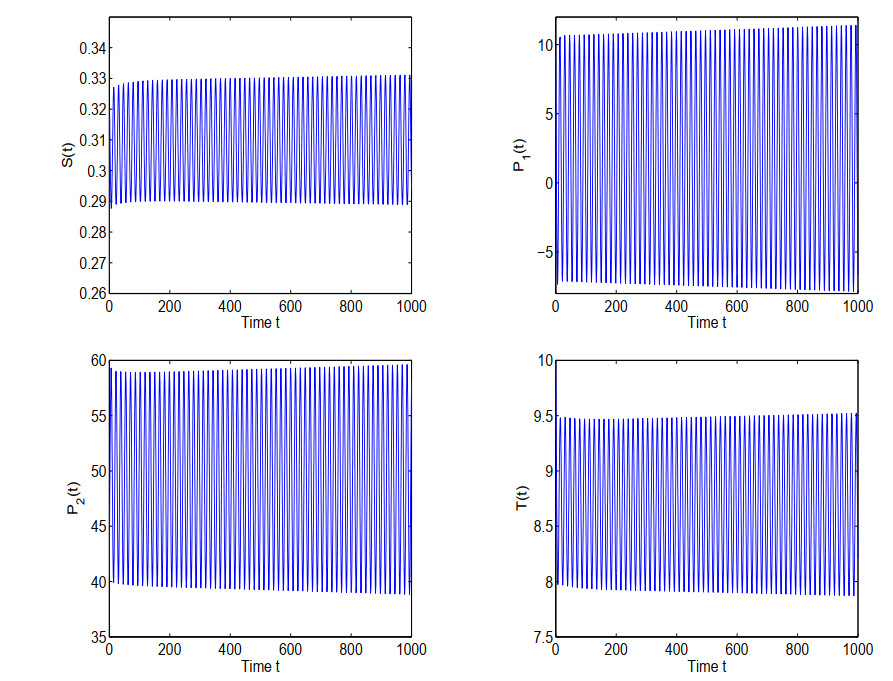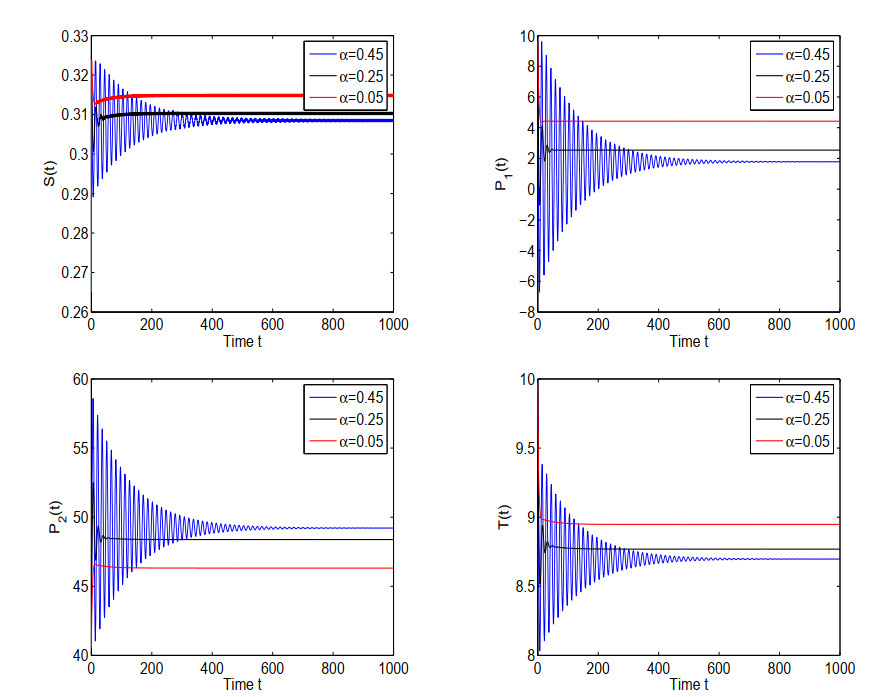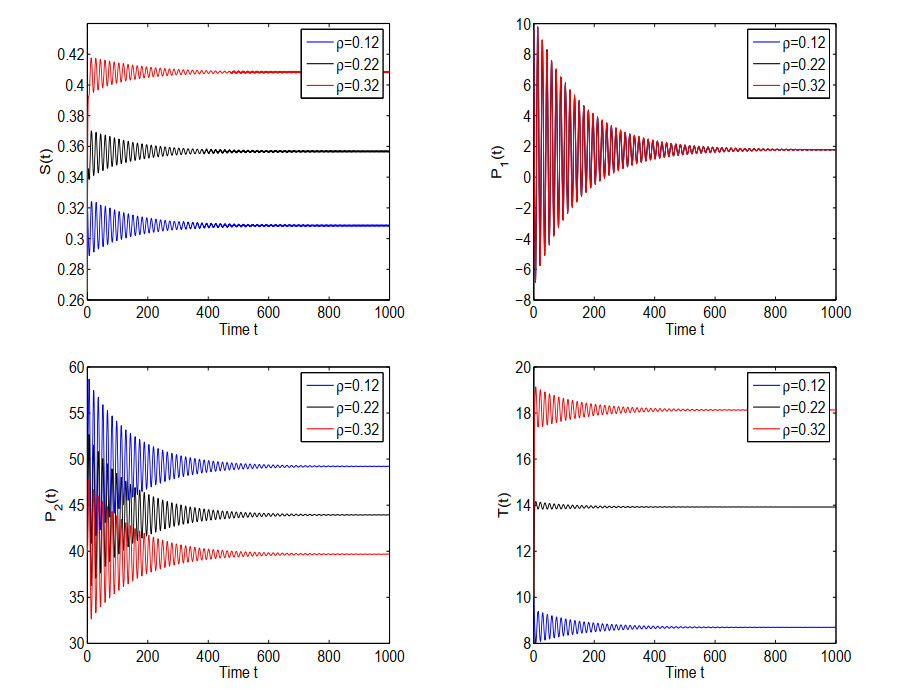This paper gropes the stability and Hopf bifurcation of a delayed synthetic drug transmission model with two stages of addiction and Holling Type-II functional response. The critical point at which a Hopf bifurcation occurs can be figured out by using the escalating time delay of psychologically addicts as a bifurcation parameter. Directly afterwards, properties of the Hopf bifurcation are explored with aid of the central manifold theorem and normal form theory. Specially, global stability of the model is proved by constructing a suitable Lyapunov function. To underline effectiveness of the obtained results and analyze influence of some influential parameters on dynamics of the model, some numerical simulations are ultimately addressed.
1.
Introduction
The derivatives of arbitrary order, where the integer-order differentiation and n-fold integration are unified and generalized, the theory of integrals is known as Fractional Calculus. Abel in 1823, described the first application of derivative of order. In 1965, the fractional derivative (FD) was introduced by Lebinitz as a generalization of the Integral order derivative. Later it was reconsidered by Euler, Abel, Riemann Liouville, Grunwald and Letnikov. In several field of research, the topic of fractional calculus plays a major role in the real world problems. Among the diverse fields of science, the fractional calculus has the great application, say in physics, thermodynamics, viscoelasticity, biology, control theory, electrochemistry [1,2,3] and acts a controller model for population growth, practically etc. In recent years, fractional differentiation has been drawing increasing attention in the study of social and physical behaviors where scaling power law of fractional order appears universal as an empirical description of such complex phenomena[4]. Over the past few decades, numerous analyses, real-world problems, and numerical methods were resolved by fractional derivatives and integrals[5]. Fractional operators used to illustrate better the reality of real-world phenomena with the hereditary property[6]. The determination of curve's shape such that the time of descent of non-friction point mass sliding down through the curve under the action of gravity is not independent of the starting point is dealt with by the tautochrome problem in which it is the relation of application of fractional calculus with the solution of integral equations. Fractional derivative are amazing tool for illustrating the memory and hereditary properties of diverse materials and processes. On finding the approximation of the solution of the system, numerical analysis have played a major role[7].
The Caputo fractional differential operator is introduced by the Italian mathematician Caputo in 1967[8]. Some problems of visco-elasticity are formulated and solved by M.Caputo [9] with his own definitions of fractional differentiation. The relationship between the Caputo Fractional Derivative(CFD) with Riemann-Liouville(RL) fractional derivative, Atangana-Baleanu(AB) fractional derivative has been very strong which describes the generalized Mittag-Leffler(ML) functions among their kernels, using certain mathematical model to obtain the results in betterment[10].
Neutral differential equations occur when max{n1,n2,......,nk}=n. The past and present values of the function is dependent by the neutral differential equations, which is similar to retarded differential equations, but the neutral differential equations also depends on derivatives with delays. Neutral type differential equations [11,12,13] acts as a model for elastic network arise in high speed computers. That is, for the use of interconnection of switching circuit. Neutral differential equation occur in various branches of applied mathematics, as a result, seeking major heed in recent decades. The development of neutral differential system have been done by many researchers, mentioning the diverse fixed point approaches, mild solutions, and nonlocal conditions[14,15]. The delay differential equations has the major application in the behaviour of real populations. The systems with impulses are utilized for studying the dynamics of processes subject to abrupt changes at discrete moments [16,17].
A set with no empty closed subset of R is called Time scale. The time scale has been introduced to federate and enhance the theory of differential equation, and many other defined difference systems. The differential equations on time scales for the existence and uniqueness of IVP has been stated by Hilger with some applications. The union of disjoint closed real intervals on time scales acts as an excellent framework for the study of population. In the last few years, differential equations in time scale is majorly developed (see for example[18,19,20,21,22,23,24,25,26,27,28,29,30,31,32]).
In [33], by applying fixed point theorems the authors discussed the existence, uniqueness and stability for the non linear fractional differential equations with non linear integral boundary condition on time scales. In our work, we discuss the existence and uniqueness solution to the neutral functional sequential integro differential equations with Caputo fractional derivative on time scale's T Cauchy problem,
Here, cΔρ, cΔϱ are CFD. The given functions are 0<ρ,ρ<1, ϕ:J×C([−ϵ,0]T,R)→R and ς∈C([−ϵ,0]T,R). The function p in [−ϵ,T]T and for ν∈J and ϵ>0, the element of Cϵ : = C([−ϵ,0]T,R) and we denote by pν as,
2.
Preliminaries
Definition 2.1. [8] The CFD of order β is defined by, for β>0,t>0,β,x,t∈R. The fractional operator is,
Definition 2.2. The mapping Σ: T→T, defined as Σ(t)=inf{s∈T:s>t} having inf ϕ=supT. The forward jump operator is defined as a Time scale with an arbitrary non empty closed subset of R and is denoted by T. (i.e., Σ(N) = N if T has a maximum N).
The mapping Ω: T→T, defined by Ω(t)=sup{s∈T:s<t} with sup ϕ=infT. (i.e., Ω(N) = N if T has a maximum N) is called the backward jump operator.
Here, the symbol ϕ denotes the empty set.
Remark 2.3. In definition 2.2, if T contains ˉn a maximum, then inf ϕ=supT (i.e., Σ(ˉn)=ˉn) and if T contains n_ a minimum, then sup ϕ=infT (i.e Ω(n_)=n), ϕ is denoted as the empty set.
Definition 2.4.[30] A continuous function u : T→R at right dense points is called rd-continuous and in left-dense points left sided limit exists.
Definition 2.5.[33] A function U: [x,y]→R is known as Δ anti-derivative of function u: [x,y]→R, where U is continuous on [x,y], Δ differentiable on (x,y), and UΔ(t) = u(t) ∀ t∈(x,y), where [x,y] is the closed bounded interval in T.
The Δ-integral of u from x to y is,
Definition 2.6.[34] The fractional integral of order β of g is,
where Γ is the Gamma function, T be a time scale with interval [x,y] of T, and g be an integrable function on [x,y].
Definition 2.7.[35] Suppose that T is a time scale. The CFD of order β of g is defined by
where m = [β]+1 and [β] denotes the integer part of β.
Theorem 2.8.[36] Let β, β′ and g be an integrable function on [x,y], then,
Lemma 2.9. (Nonlinear alternative for Leray-Schauder type)[37,38,39]. Consider U a mapping from ˉF to C, where C is a closed, convex subset of E, which is a Banach space and F, an open subset of C with 0∈F. Then either of the conditions hold:
(ⅰ) ˉF has a fixed point,
(ⅱ) f=ΛF(f), f∈∂F and Λ∈(0,1).
Lemma 2.10. (Krasnoselskii fixed point theorem)[37]. Let W be closed, bounded, convex and non-empty subset of a Banach space S. Let M, N be the operators such that (a) Mu+Nv∈W whenever u,v∈W; (b) M is continuous and compact; (c) N is a contraction mapping. Then there exists z∈W such that z=Mz+Nz.
Lemma 2.11.[20] Let T be a time scale and g be an increasing continuous function on the interval [x,y]with the time-scale. Let G be the extension of g to the real interval [x,y], then
then,
3.
Main sequels
We need the following assumptions
(A1) There exists Λ>0 such that, |ψ(ν,z)−ψ(ν,ˉz)|≤Λ||z−ˉz||c for ν∈J and every z,ˉz∈Cϵ.
(A2) There exists a non '- ve\textquoteright constant κ such that, |ϕ(ν,z)−ϕ(ν,ˉz)|≤κ||z−ˉz||c for ν∈J and every z,ˉz∈Cϵ.
(A3) The function ψ,ϕ are continuous.
(A4) There exists a continuous non-decreasing function ψ:[0,∞]T→(0,∞) and a function Υ∈C(J,J+) such that, |ψ(ν,z)|≤Υ(ν)ψ(||z||c) for each (ν,z)∈J×Cϵ.
(A5) There exists a constant L>0 such that,
where, H=Γ(ϱ+1)||ς||c+[|ϕ|+κ||ς||c+2Φo]Tϱ
(A6) There exists a continuous function ψ,ϕ:J×Cϵ→R, For each
(A7) For each ps,qs∈J such that
Remark 3.1. By (A2) for each (ν,z)∈J,
where Φo=sups∈[0,T]T|Φ(s,0)|.
Remark 3.2. A function p∈ ˜E is said to be a solution of the problem
If p satisfies the equation cΔρ[cΔϱp(ν)−Φ(ν,pν,∫t0k1(t,s,ps)ds)]=ψ(ν,pν,∫t0k2(t,s,ps)ds) on J, the condition p(ν)=ς(ν) on [−ϵ,0]T and cΔϱp(0)=ϕ.
Theorem 3.3. The function p∈ ˜E is the solution of the problem.
If
Proof. Using,
we get,
where β∈R.
Dϱp(0)=ϕ, β=ϕ−Φ(0,ς(0)), is given as,
Thus,
we find β=0 and hence the proof.
Theorem 3.4. Assume that (A1) and (A2) holds if,
then there exists a unique element for Initial value problem (1.1) in ˜E. Proof:. Choose E:C([−ϵ,T]T,R)→C([−ϵ,T]T,R) by,
Let p,q∈C([0,T]T,R). Then by (A1) and (A2) we get,
By Lemma 2.11 we get,
Thus,
The operator is contraction E. Hence, in problem (1.1) By using Banach contraction principle E is a unique solution on [−ϵ,T]T and it has a unique fixed point.
Theorem 3.5. Assume the hypothesis (A2)–(A5) hold. If κTϱΓ(ϱ+1)<1, then the IVP (1.1) must contain atleast one solution on ˜E.
Proof. Let us prove the operator E:C(−ϵ,T)T,R→C(−ϵ,T)T,R is continuous and completely continuous.
Claim 1: Let Un→y in C(−ϵ,T)T,R then E is continuous, where {Un} is the sequence. Then,
By Lemma 2.11 we get,
Since ψ and Φ are continuous functions,
as n→∞.
Claim 2: E maps bounded sets into bounded sets in C([−ϵ,T]T,R). It is necessary to prove for that k>0, and '+ ve\textquoteright constant ˜Λ such that, for every p∈Bk=p∈C([ϵ,T]T,R):||p||∞≤k. we have, ||E(p)||∞≤˜Λ.
Using (A4) and (A5), for every ν∈J, we have,
By Lemma 2.11 we get,
Thus,
Claim 3: E is mapped from bounded to equicontinuous sets of C([ϵ,T]T,R). ν1,ν2∈J,ν1<ν2,Bk is the bounded set of C([ϵ,T]T,R).Let p∈Bk.
By Lemma 2.11 we get,
Thus,
As ν1→ν2, the R.H.S of the above inequality → 0. The equicontinuity for the case ν1≤ν2≤0 & ν1≤0≤ν2 is obvious. By using Arzela Ascoli theorem, C([−ϵ,T]T,R)→C([−ϵ,T]T,R) is continuous and completely continuous.
Claim 4: A set U⊆C([−ϵ,T]T,R) with p≠mE(p) and for m∈(0,1)and p∈∂p.
Let U∈C([−ϵ,T]T,R) & p=mE(p) for some 0<m<1. Then, for each ν∈J, we have,
Considering, for every ν∈J, we obtain,
Thus,
which can be expressed as
There exists L and such that ||p||−ϵ,TT≠L, Setting for p∈{p∈C([−ϵ,T]T,R):||p||[−ϵ,T]T≤L}. From p, there is no p∈∂p such that p=mEp there exists m∈(0,1). E has a fixed point u∈ˉU by using the nonlinear alternative for Leary-Schauder type as the solution of the problem (1.1).
Theorem 3.6. Consider that (A2)–(A3) and κTϱΓ(ϱ+1)<1 holds, and (A6) |ψ(ν,x)|≤X1(ν),|Φ(ν,x)|≤X2(ν) for all (p,x)∈J×R, where X1,X2∈(J,R+). On ˜E the problem (1.1) has atleast one solution defined.
Proof. The operator Q1 and Q2:
Put
and
and define Dω=p∈C([ϵ,T]T,R)=||p||∞≤ω
Claim 1: Any sort of p,q∈Dω:Q1p+Q2q∈Dω: Any sort of p,q∈Dω. From (2.5), (2.6) and Lemma 2.11, we have,
This shows that Q1y+Q2z=Dω.
Claim 2: On Dω, Q1 is a contraction mapping:
Let p,q∈Dω. By (2.5) and Lemma 2.11 we have,
Thus,
Claim 3: Q2 and ψ is continuous so Q2 is continuous. Q2 is uniformly bounded on Dω. i.e.,
Claim 4: Q2 is equicontinuous. Defining
For ν1,ν2∈[0,T]T,ν1,ν2 by (2.6) and Lemma 2.11 we have,
As ν1→ν2 the R.H.S of the above inequality → 0. Therefore Q2 is equicontinuous, where on Dω Q2 is relatively compact. Therefore, by Arzela-Ascoli theorem Q2 is compact on Dω.
The problem (1.1) has atleast one solution [−ϵ,T]T.
4.
Example
Let us consider the fractional functional integro-differential equation on a Time scale T.
Let
For p,q∈[0,∞] and ν∈J, we have
and
And put k1=k2,
Hence the conditions (A1) and (A2) hold with Λ=κ = 1500. Thus the problem has a unique solution on [−∈,1]T.
5.
Conclusions
In this work, we obtain the existence and uniqueness solution to the integro differential equations for the Caputo fractional derivative on Time scale. The solution of the neutral fractional differential equations along the finite delay condition is derived by using the fixed point theory.
In future we look forward more on circuit analysis, in particular by using Sequential fractional order Neutral functional Integro differential equations on time scales with Caputo fractional operator over Banach spaces.
Acknowledgments
The authors extend their appreciation to the Deputyship for Research & Innovation, Ministry of Education in Saudi Arabia for funding this research work through the project number (IF2/PSAU/2022/01/21626).
Conflict of interest
The authors declare that they have no conflicts of interest.


















 DownLoad:
DownLoad: